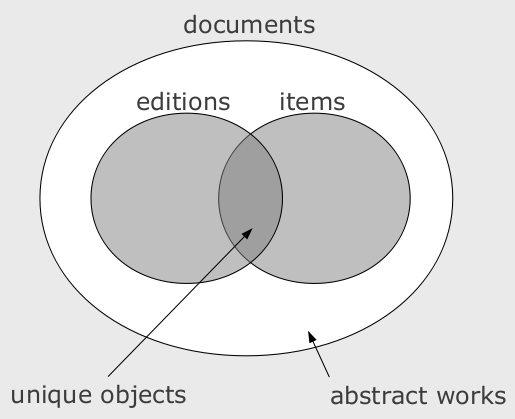Linked local library data simplified
10. Januar 2012 um 14:53 1 KommentarA few days ago Lukas Koster wrote an article about local library linked data. He argues that bibliographic data from libraries data as linked data is not „the most interesting type of data that libraries can provide“. Instead „library data that is really unique and interesting is administrative information about holdings and circulation“. So libraries „should focus on holdings and circulation data, and for the rest link to available bibliographic metadata as much as possible.“ I fully agree with this statements but not with the exact method how do accomplish the publication of local library data.
Among other project, Koster points to LibraryCloud to aggregate and deliver library metadata, but it looks like they reinvent yet more wheels in form of their own APIS and formats for search and for bibliographic description. Maybe I am wrong about this project, as they just started to collect holding and circulation data.
At the recent Semantic Web in Bibliotheken conference, Magnus Pfeffer gave a presentation about „Publishing and consuming library loan information as linked open data“ (see slides) and I talked about a Simplified Ontology for Bibliographic Resources (SOBR) which is mainly based on the DAIA data model. We are going to align both data models and I hope that the next libraries will first look at these existing solutions instead of inventing yet another data format or ontology. Koster’s proposal, however, looks like such another solution: he argues that „we need an extra explicit level to link physical Items owned by the library or online subscriptions of the library to the appropriate shared network level“ and suggests to introduce a „holding“ level. So there would be five levels of description:
- Work
- Expression
- Manifestation
- Holding
- Item
Apart from the fact that at least one of Work, Expression, Manifestation is dispensable, I disagree with a Holding level above the Item. My current model consists of at most three levels of documents:
- document as abstract work (frbr:Work, schema:CreativeWork…)
- bibliographic document (frbr:Manifestation, sobr:Edition…)
- item as concrete single copy (frbr:Item…)
The term „level“ is misleading because these classes are not disjoint. I depicted their relationship in a simple Venn diagram:

For local library data, we are interested in single items, which are copies of general documents or editions. Where do Koster’s „holding“ entities fit into this model? He writes „a specific Holding in this way would indicate that a specific library has one or more copies (Items) of a specific edition of a work (Manifestation), or offers access to an online digital article by way of a subscription.“ The core concepts as I read them are:
- „one or more copies (Items)“ = frbr:Item
- „specific edition of a work (Manifestation)“ = sobr:Edition or frbr:Manifestation
- „has one […] or offer access to“ = ???
Instead of creating another entity for holdings, you can express the ability „to have one or offer access to“ by DAIA Services. The class daia:Service can be used for an unspecified service and more specific subclasses such as loan, presentation, and openaccess can be used if more is known. Here is a real example with all „levels“:
<http://dbpedia.org/resource/Tractatus_Logico-Philosophicus>
a bibo:Book ;
daia:edition <urn:nbn:de:eki:GBV128382600> ;
daia:exemplar
<http://uri.gbv.de/document/opac-de-23:epn:266449999> .
<urn:nbn:de:eki:GBV128382600> a bibo:Book ;
daia:exemplar
<http://uri.gbv.de/document/opac-de-23:epn:266449999> .
<http://uri.gbv.de/document/opac-de-23:epn:266449999>
a bibo:Book, daia:Item ;
daia:heldBy <http://uri.gbv.de/organization/isil/DE-23> ;
daia:availableFor [
a daia:Service ;
daia:providedBy <http://uri.gbv.de/organization/isil/DE-23>
] .
I have only made up the RDF property daia:edition from the SOBR proposal because FRBR relations are too strict. If you know a better relation to directly relate an abstract work to a concrete edition, please let me know.

image created with rdfdot
Neueste Kommentare